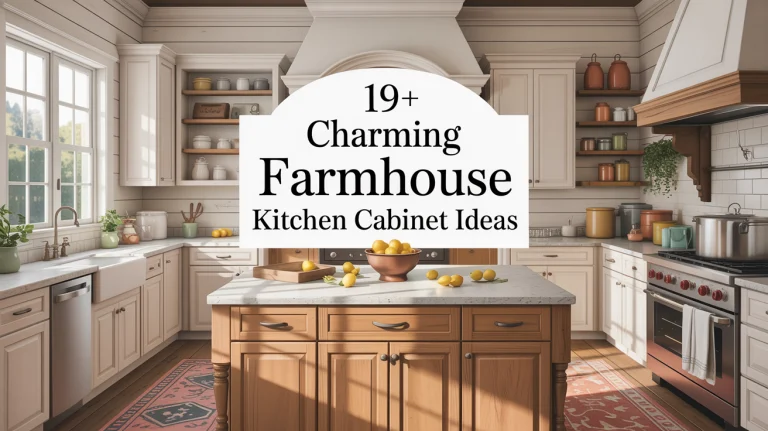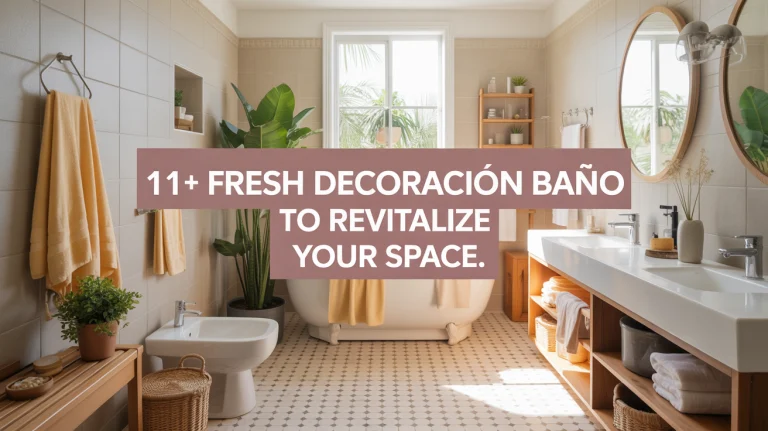17+ Charming Vintage Dining Room Ideas

1. Embrace Timeworn Wood Finishes
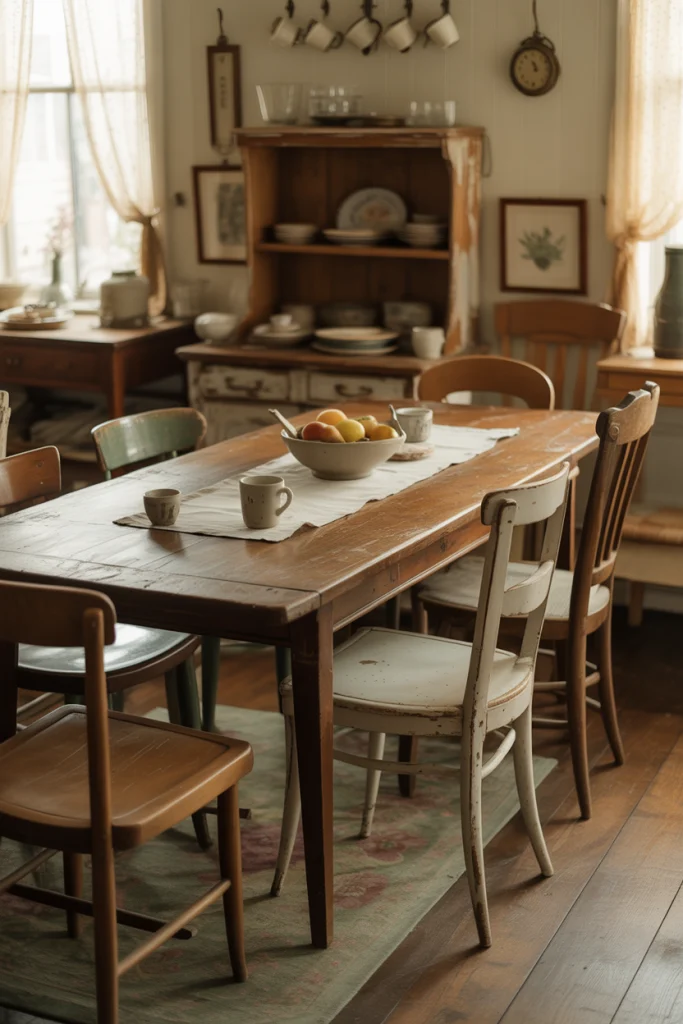
Nothing says vintage more than wood that looks like it’s lived a full life. Timeworn dining tables with nicks and faded finishes bring character to your room. Chairs with carved legs and chipped paint feel like they’ve been around for generations. These surfaces whisper stories without saying a word. When the wood doesn’t look new, your space instantly feels warmer and more real. Add a handmade touch with natural grain showing through, and your dining room starts to glow with age and charm.
2. Pick Mismatched Furniture with Meaning

Vintage style isn’t about perfection—it’s about personality. When you mix chairs, benches, and tables that don’t exactly match, your space feels collected, not copied. One chair may come from your grandmother’s house. Another might be a flea market treasure. Each piece has its own shape and soul. Together, they bring the past into the present in a way that feels homey and personal. The best part is how relaxed and welcoming it feels—like nothing’s too precious to touch.
3. Add a Weathered Hutch or Sideboard
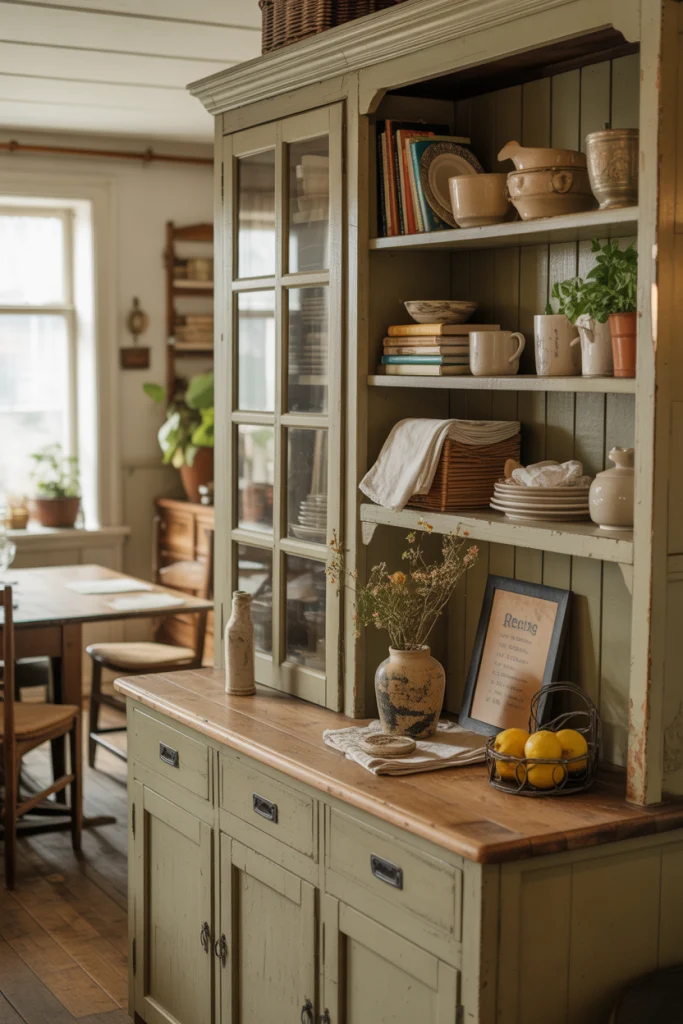
A tall hutch or sideboard with peeling paint or dark wood makes your dining room feel rooted in history. These storage pieces often show off dishes, cookbooks, or woven baskets. They stand tall like guardians of family meals past. Glass doors or open shelves let you display things you love. You don’t need fancy china—just plates with personality or mugs you’ve collected over time. When a hutch looks like it’s been around for decades, your room gets a strong sense of place.
4. Use Soft Light from Old Fixtures
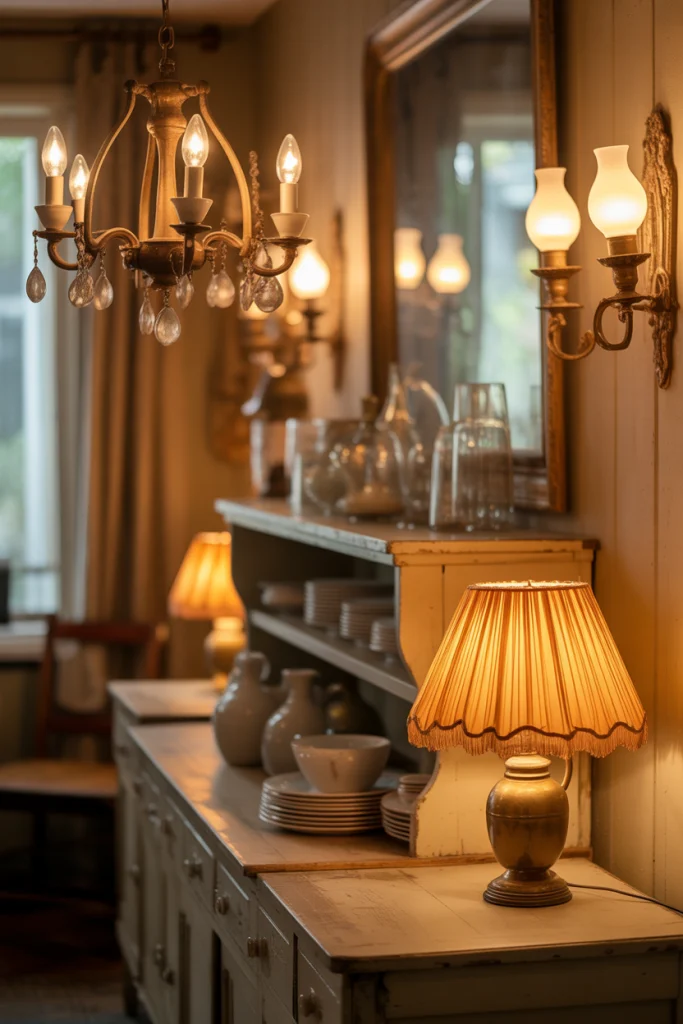
Lighting changes everything in a vintage dining space. Swap modern lights for something with age—maybe a chandelier with dangling crystals or a metal lantern with rusted edges. Look for sconces with frosted glass or lamps with pleated shades. These soft lights bring warmth and depth. They don’t scream for attention—they glow gently. When the bulbs are warm-toned and slightly dimmed, your room feels calm, like a place where stories get shared over dinner.
5. Choose Classic Prints for Upholstery and Curtains

Fabrics bring your dining room to life. Try florals that look like they were printed long ago, or stripes that feel like they came from an old farmhouse. Damask and toile also work well, adding gentle elegance. These patterns are best in faded colors like dusty rose, pale gold, or worn blue. Use them on chair cushions, seat covers, or long curtains that puddle on the floor. When the prints feel aged but cozy, your room begins to breathe in vintage style.
6. Hang Art That Tells a Story

A vintage dining room needs walls that speak. Old paintings, botanical sketches, or faded prints in carved wooden frames add soul. Look for art with muted colors or yellowed paper. Portraits of unknown people from the past bring mystery. Landscapes painted with loose strokes feel like memories. Even old mirrors can act like art when their silver backing has faded. Group items together or let one big piece take center stage—either way, you’re letting the past decorate your walls.
7. Layer Rugs for Comfort and History
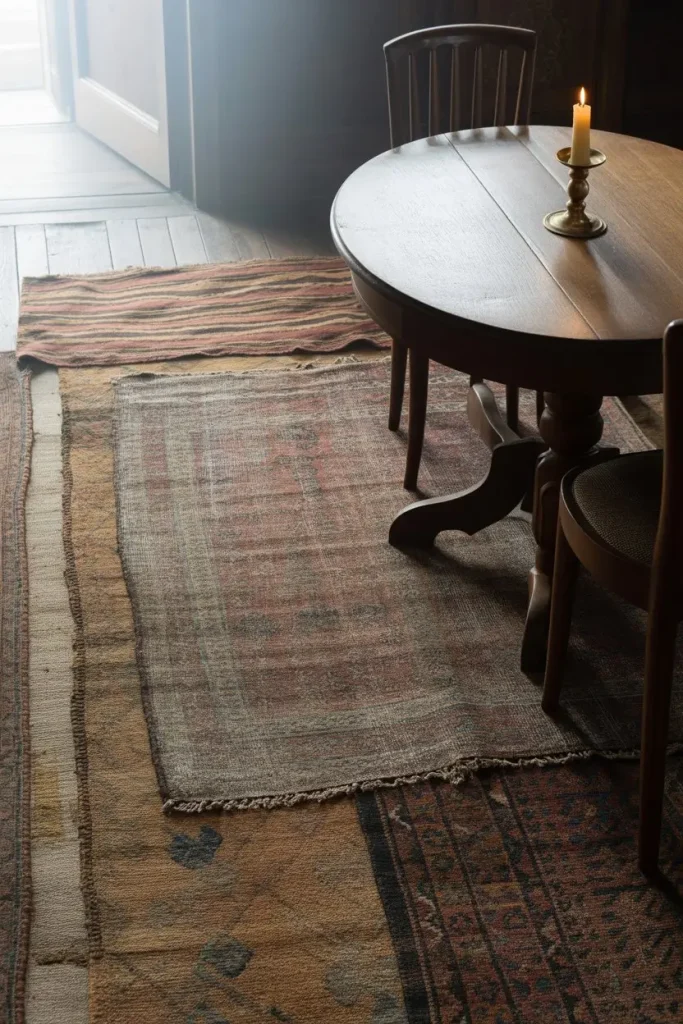
One way to make your dining room feel extra cozy is to layer rugs with age and pattern. A faded oriental rug with soft reds and blues can anchor your table. On top of that, you might place a smaller kilim rug or something handwoven. These layers tell a story. They don’t have to match. In fact, when they don’t, your room feels more relaxed and lived-in. The goal is to make it feel like your family’s been walking across those rugs for years.
8. Bring in a Touch of Iron or Brass
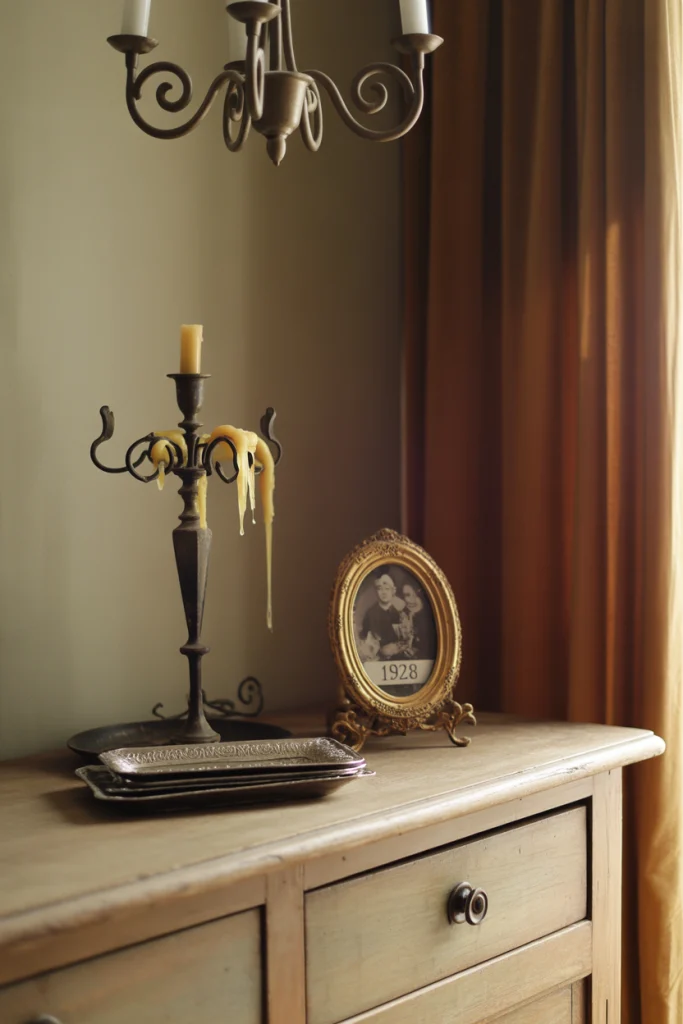
Metal works beautifully with wood and fabric in a vintage space. Iron candleholders, brass knobs, or an old metal chandelier can give the room quiet strength. Look for pieces with patina—the greenish or darkened color that happens over time. When metal ages, it softens. You can also add small things like picture frames, silver trays, or antique scissors placed artfully on a shelf. These touches may be small, but they shine in their own quiet way.
9. Let Old Dishes Steal the Show
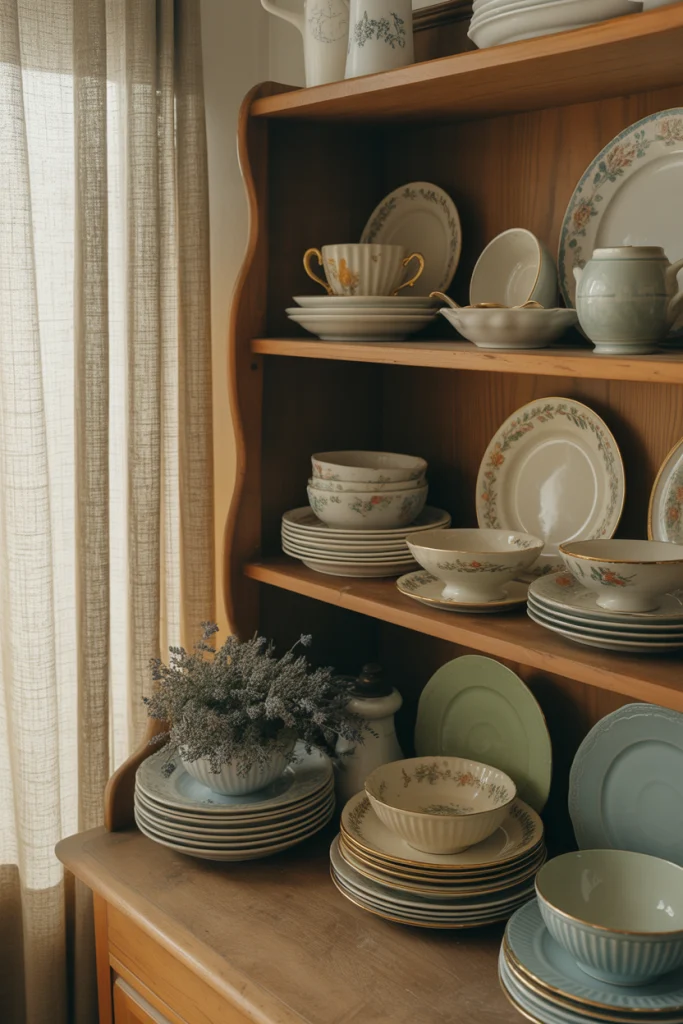
You don’t need new plates to impress guests. Vintage dishes—especially those with tiny flowers, gold rims, or scalloped edges—can take your table to another level. When stacked or displayed on a hutch, they become part of the room. Mix colors and patterns without fear. It’s okay if no two look alike. They all work together to create a table that’s full of warmth and memory. Even chipped pieces can feel special when paired with love.
10. Frame the Room with Wainscoting or Wallpaper
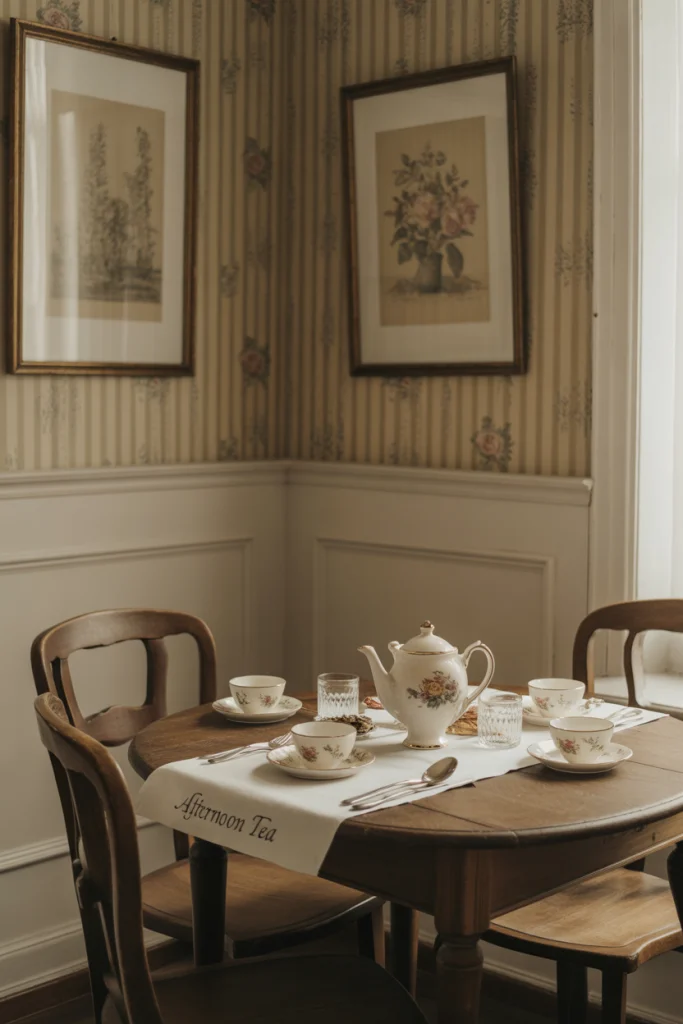
Sometimes, the structure of the room needs to join the style. Wainscoting in white or cream adds depth to your walls and brings an old-home feeling. Pair it with wallpaper that looks aged—something with faded roses, ticking stripes, or tiny vines. The mix of texture from the wood and the gentle print above makes your room feel complete. It’s not just decorated—it’s built for vintage living. Even if your home is new, this trick makes it feel like it’s been around for ages.
11. Show Off Treasures on Open Shelves
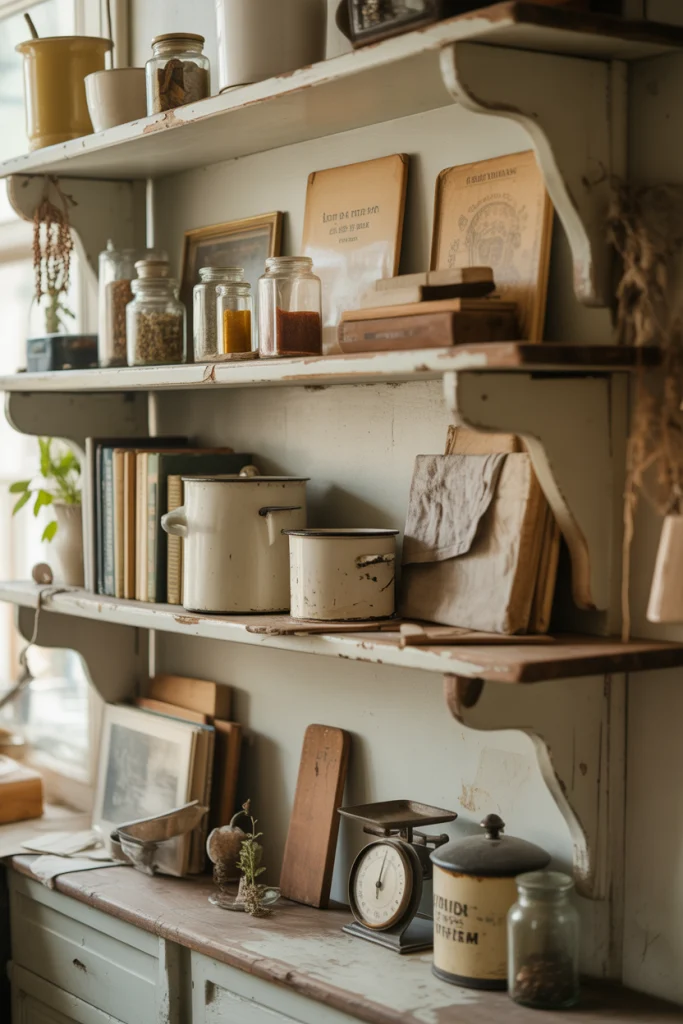
Display is part of the charm in a vintage dining room. Open shelves filled with glass jars, cookbooks, or enamel pots feel both useful and nostalgic. When shelves are worn or uneven, they add to the story. Each item on display should feel like it has meaning. Maybe it’s your grandmother’s rolling pin or a jar of old buttons. These little touches make the room feel personal, not staged. They give your space a lived-in grace.
12. Let Plants Bring Gentle Life
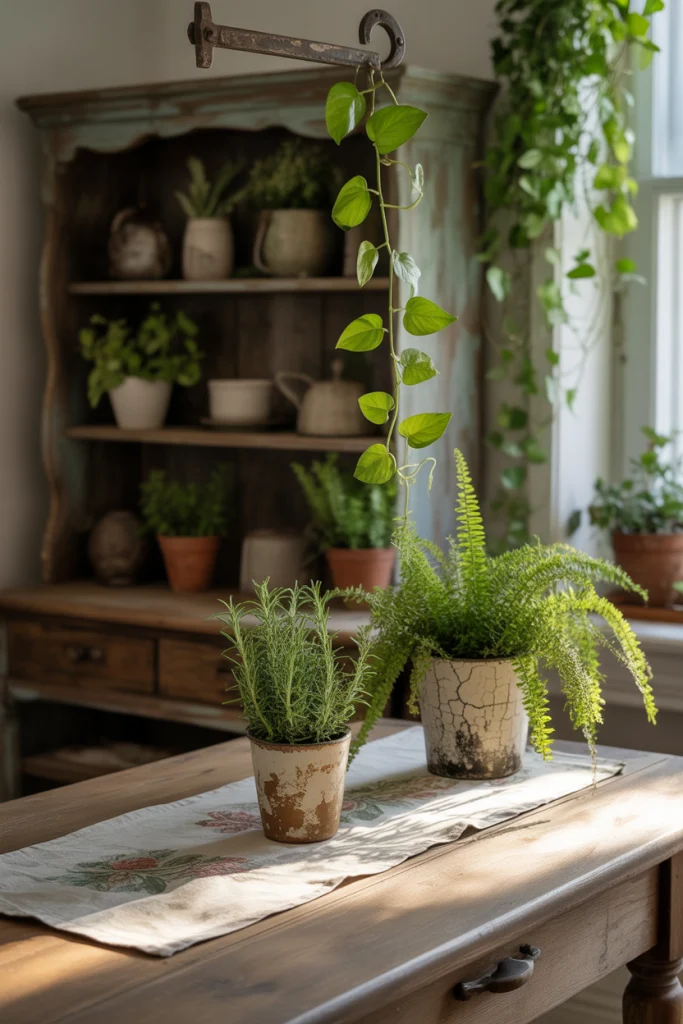
Vintage doesn’t mean lifeless. Add potted plants in ceramic or clay pots to bring softness and movement to your dining room. Ferns, ivy, and pothos all work well because they spill and drape. Herbs like rosemary or thyme in little cups add both beauty and scent. When plants look a little wild—not perfectly trimmed—they add a sense of nature that fits vintage style. They remind us that homes are alive and always growing.
13. Bring in a Touch of Lace or Crochet
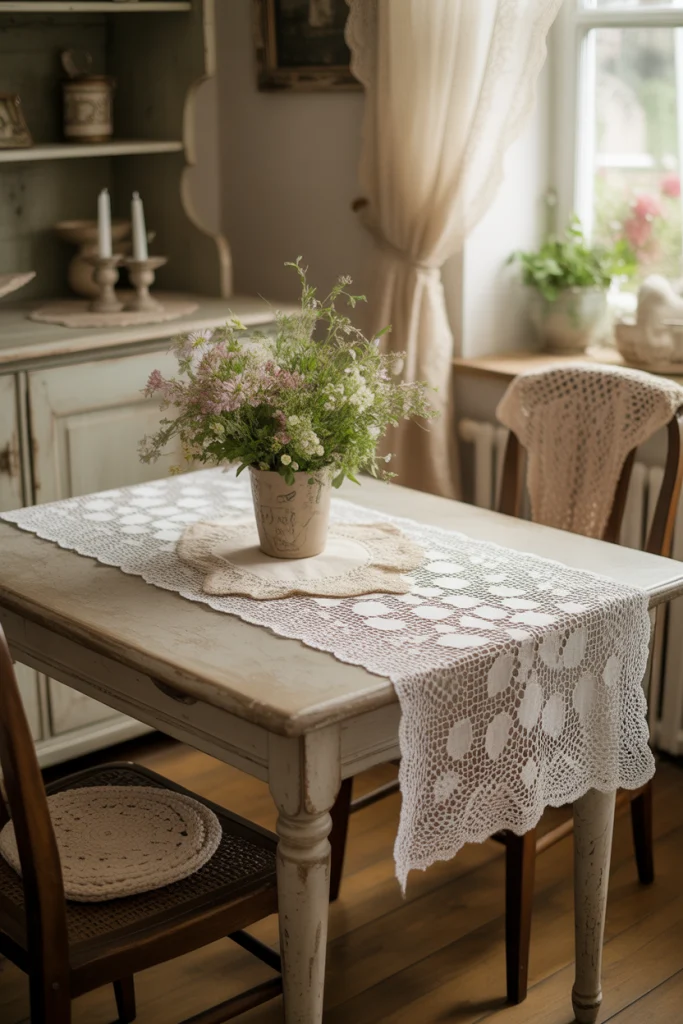
Textiles with texture give your space a handmade feeling. A lace tablecloth that drapes softly or a crochet runner over the sideboard adds detail without being loud. You don’t need a full set. Even a small doily under a vase or a bit of lace edging on curtains can speak volumes. These pieces often come from family trunks or thrift shops and carry a gentle, feminine charm. They make your space feel soft and special.
14. Keep Colors Muted and Calm
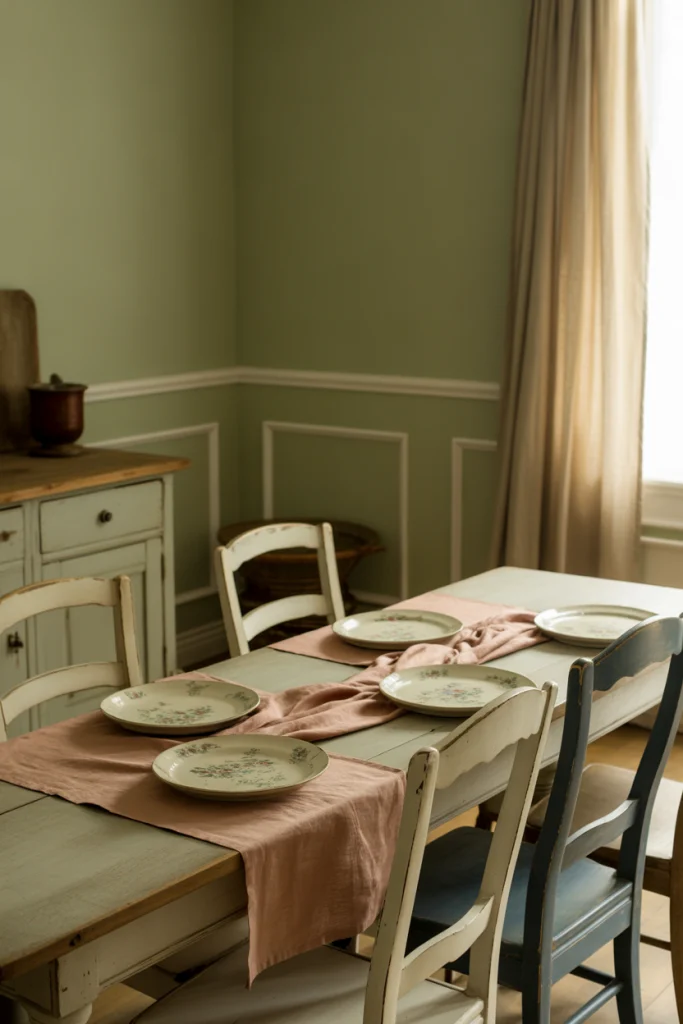
Vintage dining rooms don’t shout—they whisper. Choose soft, faded colors like pale blue, sage green, or creamy white. These shades don’t tire the eyes. They make the room feel easy to sit in for hours. You can layer in darker wood or deep rusts and blues for contrast, but nothing should feel too bright. The goal is comfort and calm, like the colors have aged beautifully over time. When your eyes rest easy, your heart feels at home.
15. Use Furniture with Curves and Character
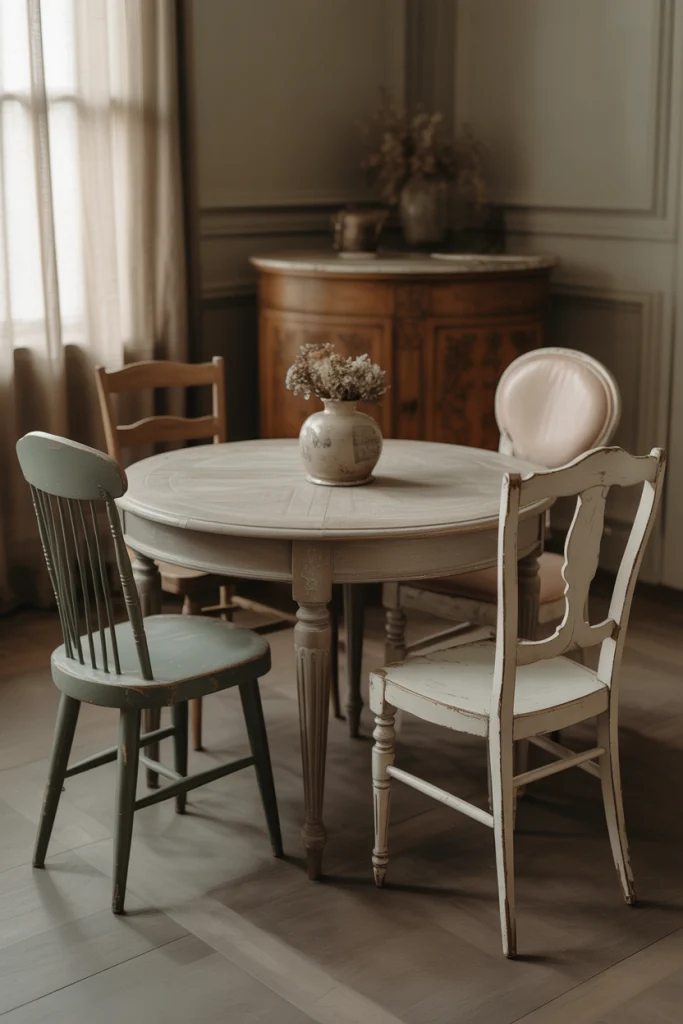
Straight lines can feel modern. In a vintage space, go for curved legs, rounded chair backs, and gently shaped arms. These shapes feel older, softer, and more inviting. They’re found in Queen Anne chairs, French-style buffets, and spindle-back dining seats. The curves add elegance without being fancy. They show that style doesn’t have to be sharp to be strong. When your furniture moves with graceful lines, your whole room feels more welcoming.
16. Layer Table Settings with Soul
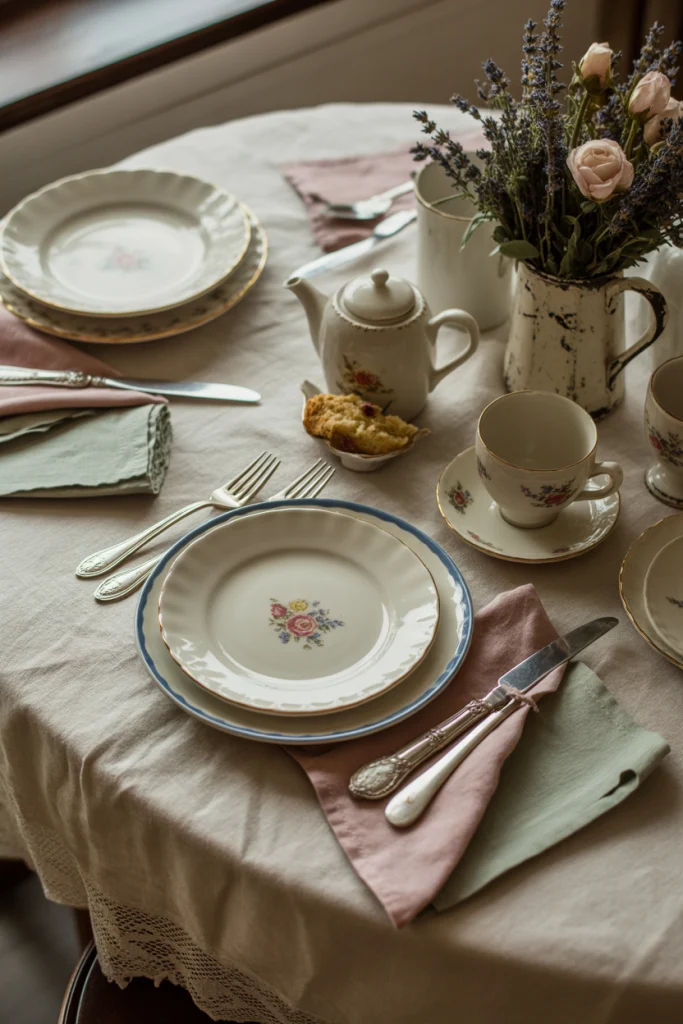
Don’t save your vintage plates and linens for holidays. Use them every day to add joy to meals. Layer a tablecloth with an old runner or place mats made from linen. Use mismatched napkins or silverware with floral handles. Even if you’re just having tea, set the table like it matters. These little acts of care turn eating into an experience. They help your home feel alive with tradition, beauty, and thoughtfulness.
17. Add a Touch of Whimsy with Found Items
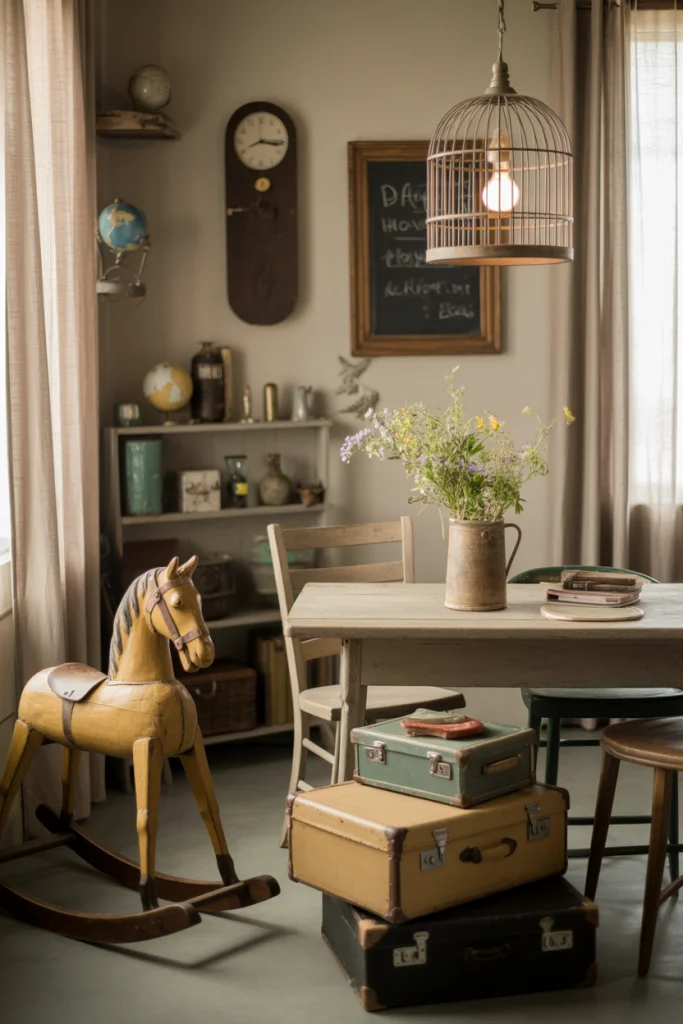
A vintage dining room doesn’t have to be serious. Add fun with things that surprise the eye. Maybe it’s a birdcage turned light fixture or a schoolhouse clock hanging just a little too low. You might place a child’s old rocking horse in the corner or stack vintage suitcases as a side table. These found objects make people smile. They show that your home isn’t just stylish—it’s playful, too. And playfulness is part of charm.
18. Let the Room Evolve with You
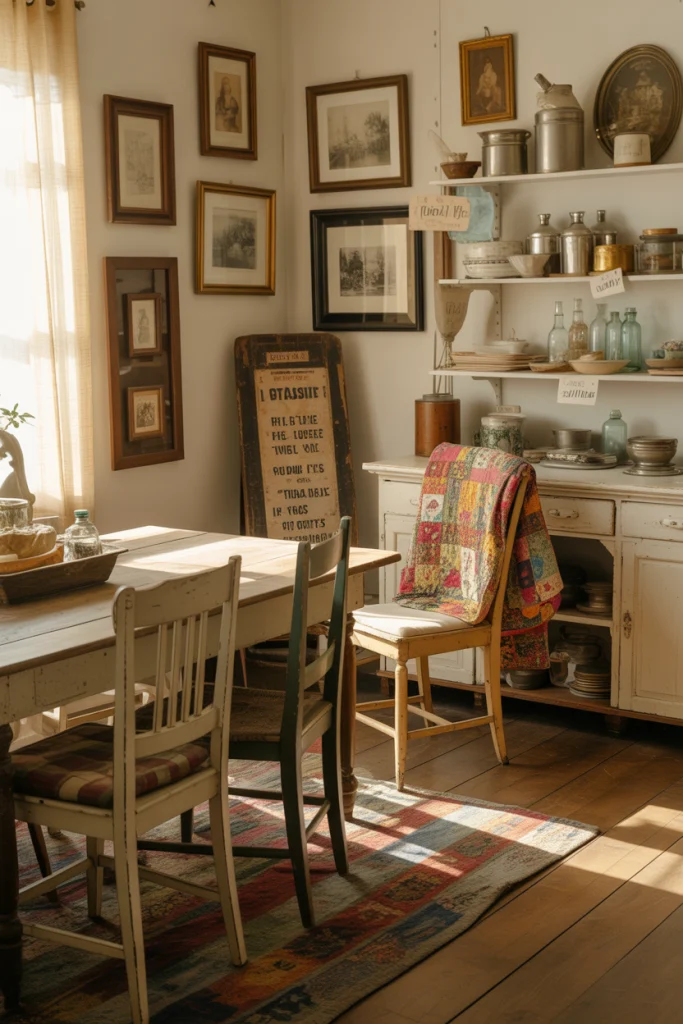
The best part of a vintage dining room is that it’s never done. You can keep adding to it as you find new treasures. Maybe it’s an old sign you spotted on a road trip or a handmade quilt you discovered at a garage sale. Each time you bring something in, your room grows. It becomes more yours. More lived in. More loved. A vintage dining room is a place where life happens slowly and sweetly—and always with style.



